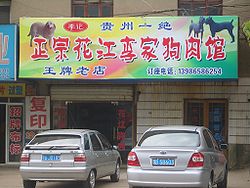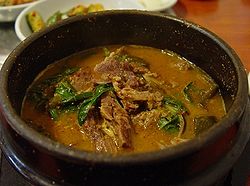Cookbook:Dog
Cookbook | Recipes | Ingredients | Equipment | Techniques | Cookbook Disambiguation Pages | Ingredients | Meat and Poultry




Introduction
Dog meat refers to edible parts and the flesh derived from (predominantly domestic) dogs. Human consumption of dog meat has been recorded in many parts of the world, including ancient China, ancient Mexico, and ancient Rome.
The eating of dogs has been recommended by officials as a means of dealing with the rampant breeding of the stray animals. In Malaysia the Deputy Directorgeneral of the Veterinary Services Department (DVS) has stated that stray dogs held at pounds should be sold for human consumption as a method of stray management.[1][2] In Thailand, unofficial dog-collectors collect roughly 30,000 free-roaming strays for export to Vietnam, sparing the country the economic problems of the issue - no overcrowded cells full of animals packed closely together or expensive chambers with no other purpose than to kill animals with meat being wastefully incinerated, but instead turn it into a trade with economic benefit.
Thailand's Nakhon Phanom province police chief, Maj. Gen. Panamporn Eithiprasert - who claims the highest volume of narcotic seizures in the region - has said "Yes, we could catch dogs. But then they’d become our burden. If someone else collects them, isn’t that a good thing? With drugs, even a small amount can ruin lives. With illegal immigrants, they take jobs from Thais. But stray dogs? Is anyone taking something from us that we value?"[3] The mayor of Baan Pehng province in Thailand compared dog collectors to dustmen in a 2007 Thai TV documentary, saying "Society says those who trade dogs are low-lifes. But I’m a politician and I say it’s an honest business. It’s like selling garbage to foreigners for a profit."[3]
In Vietnam's Ho Chi Minh City, the city's Animal Health Agency head, Phan Xuan Thao, called for greater regulations to ensure dog meat safety, such as ensuring they "must have a clear origin", be "vaccinated against rabies and other diseases and quarantined 15 days before being slaughtered" on 19 July 2010 in Thanh Nien Weekly, however Vietnam's Inf.VN news network said "the regulations await action from central authorities and the industry in currently remains largely unregulated".[4] A 2007 study by Vietnam's National Institute of Hygiene and Epidemiology showed that 20 percent of sick dogs tested in Hanoi area slaughterhouses tested positive for rabies.[4] In early June 2010, officials from the Hanoi Department of Health closed dozens of dog restaurants and slaughterhouses in Hoai Duc and Ha Dong districts after samples of dog meat tested positive for cholera.[4]
In Korea's capital, Seoul the first ever health inspection of illegal dog meat restaurants was launched in April 2008, with officials stating "Many citizens enjoy dog meat despite the ban. But there have been no hygiene regulations on their slaughter and trade because dogs are not classed as livestock".[5] The city government has proposed reclassifying dogs as livestock so it can set food safety standards but the proposal sparked angry reactions from animal rights activists, who staged street protests and launched online signature campaigns.[5] The Associated Free Press has stated "slaughtering and processing is carried out in dirty environments and poses a risks to diners' health" and that the reason for driving the trade underground was "to avoid adverse [Western] publicity before the 1988 Olympics."[5]
Recipes
- Anjing Panggang — Indonesian/Malaysian-style Grilled Dog in Spicy Marinade
- B1, a popular Indonesian dog-meat dish also known as RW, rica-rica, rintek wuuk, rica-rica waung and guk-guk
- Bosintang or "woof woof soup" (also known as gaejang-guk— with vegetables such as green onions, dropwort and perilla leaves with spices such as perilla seed powder, soybean paste fermented with dried rice plants and brine (doenjang), red chilli, rice and fermented soybean powder paste (gochujang). Variations of the dish contain chicken and bamboo shoots.[6]
- Gaegogi Jeongol — A Korean recipe for an elaborate dog stew made in a large casserole (Jeongol) pan.
- Gae Suyuk — Boiled dog meat Korean-style
- Gaesoju — Korean mixed drink containing dog meat, ginger, chestnut, and jujube
References
- ↑ Eat the dogs in the pounds, says Deputy DG of Vet. Services Malaysia (Webcitation Archive), The Sun [Malaysia], March 7 2010
- ↑ 'Why Not Eat Dogs?' (Webcitation Archive), by Darshini Kandasamy, The Malay Mail
- ↑ a b Eating Dogs, GlobalPost, May 2010
- ↑ a b c HCMC official calls for regulation on dog meat trade (Webcitation Archive), Info.VN, 26 July 2010
- ↑ a b c Seoul dog meat eateries face first hygiene crackdown (Webcitation Archive), Associated Free Press, 13 April 2008
- ↑ Pettid, Michael J., Korean Cuisine: An Illustrated History, London: Reaktion Books Ltd., 2008, 84-85.
